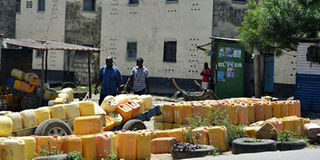Shocking reality of Kenya's water crisis

Vendors fetch water to supply to residents of Changamwe in Mombasa County on September 19, 2019. Nairobi, Mombasa, Kisumu, Eldoret and Nakuru risk suffering debilitating shortages in the next 10 years if nothing is done to correct the situation. PHOTO | KEVIN ODIT | NATION MEDIA GROUP
What you need to know:
- The Northern Collector Tunnel, for instance, will cost roughly Sh6.5 billion upon completion and pump an additional 140 million litres of water into the city.
- Parklands, Eastleigh, Karen, Kilimani, Kileleshwa and Westlands districts of Nairobi are considered high-level hotspots of groundwater abstraction and borehole proximity.
- There are 18 gazetted water towers in the country and another 11 newly identified towers are ready for gazettement.
Except Kisumu, most of Kenya’s other major cities get much of their water supplies from basins outside where the cities are located, and with those sources fast drying out, it is only a matter of time before people run out of water and patience
Kenya is running on an empty tank as dwindling water resources coupled with a ballooning population empty dams and catchment areas, a Nation study shows.
The problem is compounded by poor management of current water resources, short-term planning, and climate change.
Experts are now warning that Nairobi, Mombasa, Kisumu, Eldoret and Nakuru risk suffering debilitating shortages in the next 10 years if nothing is done to correct the situation.
The biggest concern is on the future of the capital city, Nairobi, which, according to data by the Water Resource Authority, requires at least 1.5 million cubic metres of water daily but only gets 782,000 cubic metres, or about half of the daily need.
To put things in perspective, if one cubic meter is equal to 1,000 litres, it means the city has a shortfall of 718 million litres of water a day.
HUGE CONSUMPTION
Dr Isaac Kalua, chairman of Kenya Water Towers Agency (KWTA), says this is just a tip of the iceberg and links the growing popularity of boreholes to the fact that more than half of the city does not have access to treated piped water.
The statistics are a bit confusing. For instance, the 2009 population census reported that eight out of every 10 households in Nairobi (76 per cent) had piped water, but the taps appear to have run dry in the 10 years since.
Nairobi is particularly important in the water debate because, by virtue of it being the capital city and seat of national government, it consumes the highest amount of water annually compared to other towns.
The Nairobi City Water and Sewerage Company, which is the largest water service provider out of the 70 in the country, accounts for 28 per cent of national water coverage.
That explains why experts believe the greatest water resource pressure will be felt in the city. Currently, the city’s plan to quench its humongous thirst runs into billions of shillings.
The Northern Collector Tunnel, for instance, will cost roughly Sh6.5 billion upon completion and pump an additional 140 million litres of water into the city.
BOREHOLES
The tunnel will be 11.8 kilometres long and 3.2 metres wide.
It will collect 40 per cent of floodwater from rivers in Murang’a County — Gikige, Irati and Maragua — and direct it to the Gigiri distribution point, from where it will be pumped to the rest of the city and its environs.
But this water, once it starts flowing next year, will not just be for Nairobians. Engineers plan to build a line from Gigiri to the Embakasi neighbourhood, one of the city’s most water-scarce districts.
The same line is expected to serve Mavoko, Kitengela and Ongata Rongai, which have mainly depended on untreated borehole water.
In fact, save for a few hundreds, Nairobi and Mombasa seem to be running on borehole water.
Information on the number of wells and boreholes in Kenya is scanty, but a 2015 study by Mr Nato Simiyu of the Department of Civil and Construction Engineering at the University of Nairobi titled "Groundwater Management Practice in Nairobi County", found that the city had 2,632 boreholes as at July 2015.
To arrive at this number, Mr Simiyu combined the WRA borehole listing number with Google Earth files of all licensed boreholes in the city.
But this total could be in the upwards of 6,000 if both legal and illegal boreholes are well enumerated.
UNDUE PRESSURE
The Parklands-Westlands district of the city had the highest number of boreholes, at 808, consisting 31 per cent of the total.
Kibra followed with 620 (24 per cent) and Embakasi at 447 (17 per cent). The city centre and Pumwani had the least number of boreholes, with 84 (three per cent) and 94 (four per cent), respectively.
At the location level, Parklands, Karen/Lang'ata and Kilimani had the most boreholes, at 518, 434 and 290, respectively.
On the lower end were Pumwani, Kariobangi and Korogocho locations, with one, two and three boreholes, respectively.
Data analysis showed that each administrative location in Nairobi had, on average, 88 boreholes.
Also, the middle- and upper-middle classes had more access to water than the poor, either because they had the capacity to sink boreholes or had more reliable supplies from City Hall.
But boreholes cannot solve the water crisis, and over time they have got deeper in Nairobi due to the topmost aquifer being polluted and overabstracted.
Now most residents are abstracting from the second aquifer, which is also overexploited.
WORRYING DEPTH
Four years ago, the drilling depths ranged between 30 and 820 metres. About 56 per cent of the mapped boreholes were 200 metres apart while 26 per cent were barely 100 metres apart.
And that complicates the overextraction problem. “One of the licensing conditions is to limit the distance from one borehole to another to 800 metres so that we do not have dead boreholes, because most firms compete for supply from the same sources,” said Water minister Simon Chelugui in a past interview.
Data from the Water ministry shows that in 2018 alone, 182 contractors were licensed to drill boreholes up to a maximum depth of between 50 and 300 metres in classes D and B, respectively.
Class C contractors are allowed to drill to depths of 150 metres while class A is unlimited. Only 20 out of 182 contractors had been licensed to drill boreholes of unlimited depths.
But at the start of the year, the government issued a directive stopping further drilling of boreholes in Nairobi, Kiambu and Machakos counties, indicating in the communication that it planned to invest in water sources outside the counties as a way of limiting borehole numbers per area.
The WRA considers Parklands, Eastleigh, Karen, Kilimani, Kileleshwa and Westlands districts of Nairobi to be high-level hotspots of groundwater abstraction and borehole proximity, while Industrial Area, Mombasa Road and Imara Daima are considered mid-level.
CONFLICTS
Dr Marani says most major towns’ current water demand exceeds supply because populations and consumption have been growing faster than growth in water supply infrastructure development.
Except Kisumu, most of the other major cities get much of their water supplies from basins outside where the cities are located.
“For example, Nairobi is located on Athi River Basin but gets more than 80 per cent of its water supplies from Tana River Basin, specifically Murang’a County. Nakuru gets much of its water from sources in Nyandarua County, Mombasa from Taita-Taveta County and new sources are being developed in Kwale County, while Eldoret gets much of its water supplies from Elgeyo-Marakwet County.
“As source counties develop, especially in the light of Vision 2030, they will also require these waters, hence county-county water conflicts are expected,” says Dr Marani.
Except for Nakuru that gets significant water supplies from ground sources, most other major cities get most of their water from surface sources like rivers and lakes.
The supply capacity of these surface sources is known and is the basis of future development of supply infrastructure.
WATER TOWERS
The WRA, formerly Water Resource Management Authority, has six major water catchment areas: Lake Victoria North Catchment Area and Lake Victoria South Catchment Area, Rift Valley Catchment Area, Athi Catchment Area, Tana Catchment Area, and Ewaso Ng’iro North Catchment Area.
The Athi, Ewaso Ng’iro and Tana drainage systems all flow towards the Indian Ocean, with the highest water availability of more than 50 per cent coming from Lake Victoria and the lowest being from the Athi Drainage system.
Only the Tana and Lake Victoria basins have surplus water resources as the three other basins face deficits.
There are 18 gazetted water towers in the country and another 11 newly identified towers are ready for gazettement.
However, only five major water towers out of the 18 play a critical role in water catchment: Mt Kenya, Aberdare Range, Mau Complex forests, Cherangani Hills and Mt Elgon.
These are the lungs of the country, without which there would be no life.
Nairobi receives its water resources from two drainage systems — Kikuyu Springs and Ruiru Dam — which lie in the Athi belt, and three other sources from the Tana belt: Ndakaini-Thika Dam, Chania-B Dam and Sasumua Dam.
The capital gets an additional 20 per cent of its water supply from ground resources.




